

FOI 24-31 - Doc 3
Environmental Management of Changes to
Aircraft Operations
AA-NOS-ENV-2.100
Version 10
Effective 20 October 2017
Prepared: s47F
Environmental Systems and Assurance
Manager
Endorsed
s47F
Standards and Systems Manager
Authorised: s47F
Executive General Manager, Safety and
Assurance
pursuant to the Freedom of Information Act 1982 by Airservices Australia
Released
Uncontrolled if printed
© Airservices Australia 2017
1 of 22
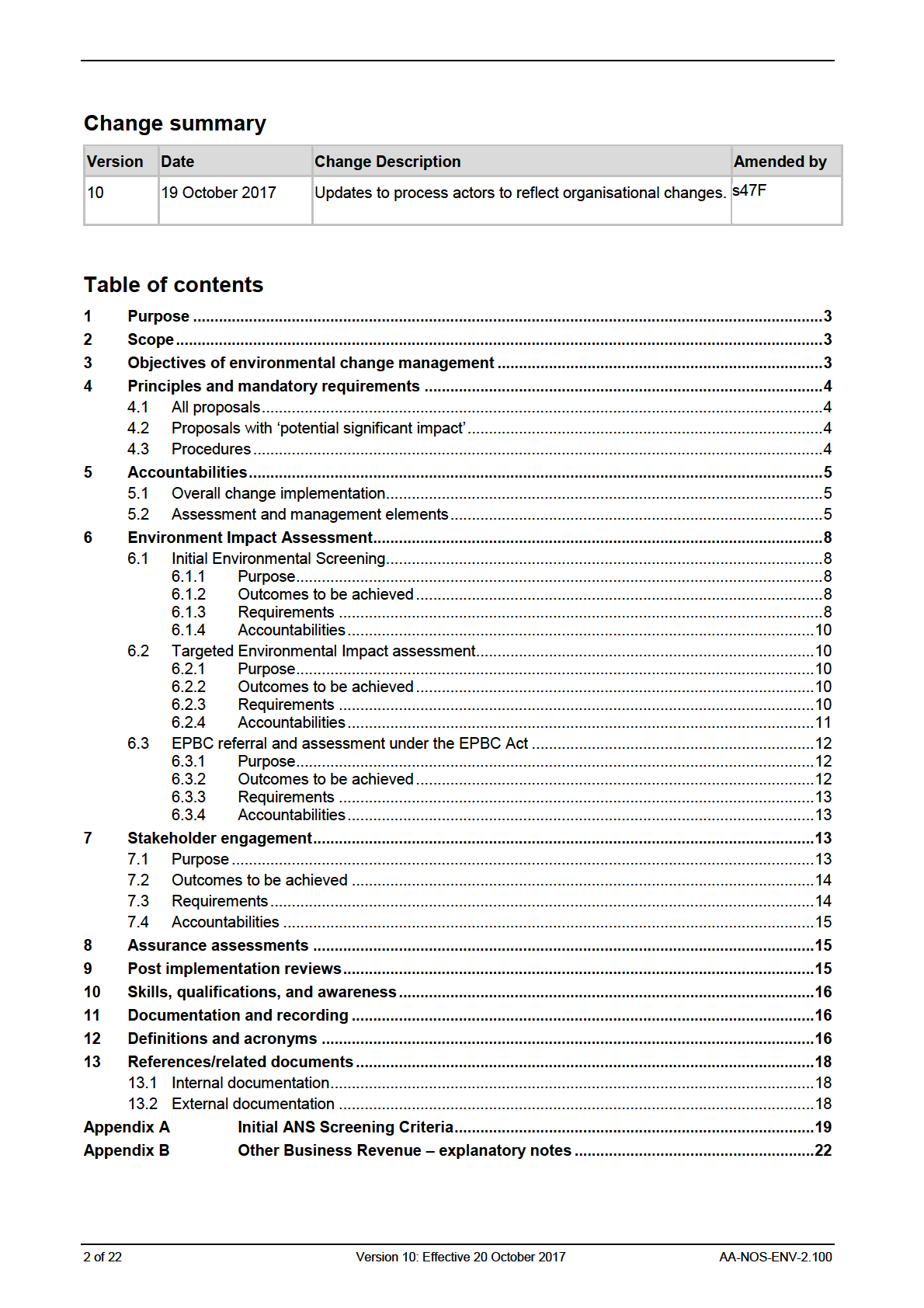
FOI 24-31 - Doc 3
pursuant to the Freedom of Information Act 1982 by Airservices Australia
Released
FOI 24-31 - Doc 3
1
Purpose
The purpose of this National Operating Standard (NOS) is to prescribe the
requirements for environmental impact assessment (EIA) and stakeholder engagement
that must be met by Airservices, prior to the implementation of changes to aircraft
operations.
These activities shall be collectively referenced as environmental change management
from here on in this document.
2
Scope
This NOS applies to all Airservices proposed changes to air traffic management
practices (Proposals) that may involve a change to aircraft operations.
Proposals include, but are not limited to, the following changes:
• A new, or amendment to an existing, instrument approach;
• A new, or amendment to an existing, flight path or air route;
• Re-classification of airspace;
• Change to preferred runways;
• Change in time of day of operation (e.g. amendments to tower hours of
operation – the time of day that a tower operates may alter the flight path used
by aircraft);
• A change that allows use of a flight path/airspace by a different type or number
of aircraft;
Note:
A tactical decision of an air traffic controller to alter the track of an individual
aircraft does not constitute a Proposal.
This NOS does not necessarily apply to other business revenue (OBR) work
undertaken by Airservices. For OBR work, an approach shall be determined by the
EGM Air Navigation Services (ANS), to assess application of the EPBC Act and the
impact of the work on environmental related business.
Refer to Appendix B for further information regarding OBR work.
3
Objectives of environmental change management
The main objectives of environmental change management for aircraft operations are
to:
1.
Meet Airservices’ Legislative obligations to:
a.
minimise significant environmental impacts resulting from any Airservices
pursuant to the Freedom of Information Act 1982 by Airservices Australia
action, and ensure appropriate environmental assessments are
undertaken, as required under the
Environmental Protection and
Biodiversity Conservation Act 1999 (EPBC Act);
b.
ensure air traffic management practices are conducted in a manner that
protects the environment, as far as is practicable, as required under the
Released
Airservices Act 1995;
c.
meet ministerial directions relating to aircraft noise management;
2.
Minimise Airservices business risks by maintaining effective stakeholder
engagement and sound corporate citizenship in aircraft noise management;
AA-NOS-ENV-2.100
Version 10: Effective 20 October 2017
3 of 22
FOI 24-31 - Doc 3
3.
Provide a standardised and rigorous approach to assessing the impacts of
changes to aircraft operations, as a demonstration of organisational due diligence
in environmental management (in compliance with the requirements of
Airservices ISO 14001 aligned EMS - as described in AA-NOS-ENV-0001);
4.
Assist in achieving organisational environmental, sustainability and community
management commitments (as described in the Environmental Policy C-
POL0030);
5.
Assist in achieving efficiency outcomes for Airservices customers, through
improved flight paths and associated reductions in fuel costs and emissions.
4
Principles and mandatory requirements
4.1
All proposals
All proposed changes to Airservices’ air traffic management practices that may affect
aircraft operations shall:
1.
Be assessed for environmental impact prior to implementation;
2.
Undergo stakeholder engagement planning and stakeholder consultation prior to
implementation where potential community or environmental impacts are
identified;
3.
Be reassessed prior to implementation, if the proposal has already been impact
assessed in accordance with this NOS and:
a.
has subsequently been modified or;
b.
over 18 months has elapsed since the initial assessment process;
4.
Be undertaken in accordance with this National Operating Standard (NOS) (and
associated documentation).
4.2
Proposals with ‘potential significant impact’
Any proposal that results in an EPBC Act assessment finding of ‘
potential significant
impact”, shall be referred, by the EGM ANS to the Commonwealth Environment
Portfolio Minister (the Environment Minister) for advice, (unless the Proponent decides
not to proceed with the proposal).
Once advice is received from the Environment Minister:
• the Environment Minister’s advice shall be considered by the CEO; and
• the action taken (e.g. in relation to implementation of the proposal) shall be
recorded, and if the Minister’s advice was not given effect, the reasons why,
shall be documented and forwarded to the Environment Minister, by the CEO, in
accordance with the EPBC Act.
pursuant to the Freedom of Information Act 1982 by Airservices Australia
Refer to Section 6.3 for further information regarding EPBC Act assessment
requirements.
4.3
Procedures
Released Airservices business groups with accountabilities for planning and implementing
changes to aircraft operations (as indicated in this NOS) shall develop procedures that
describe:
4 of 22
Version 10: Effective 20 October 2017
AA-NOS-ENV-2.100
FOI 24-31 - Doc 3
• The internal business processes required to enact the requirements of this NOS
(including interactions with other business groups and external stakeholders);
• The relevant methodologies for undertaking the environmental assessments
described in this standard;
• The relevant methodologies for planning, undertaking and documenting
stakeholder engagement and community consultation.
5
Accountabilities
5.1
Overall change implementation
ANS holds ultimate accountability for ensuring that no aircraft change is implemented
without appropriate environmental impact assessment and stakeholder management in
accordance with this NOS.
In practice this means:
• Project managing the change process to ensure that all assessment and
management elements are completed and endorsed by relevant managers;
• Accepting or rejecting risk determinations in CIRRIS, from the environmental
assessment and management elements (in accordance with the Risk
Management Standard AA-NOS-RISK-0001);
• Authorising implementation of the change once all assessment and
management requirements (as described in this NOS) have been met.
• The Accountable ANS Manager is the clear point of accountability for the overall
success of a change. The Accountable ANS Manager is either:
o The Northern or Southern Operations Manager; or
o the EGM ANS if the proposed change represents a class B risk.
5.2
Assessment and management elements
A range of accountabilities and responsibilities are held by other Business Groups and
stakeholders, to ensure delivery of key assessment and management elements
described in this NOS.
Key roles in the change management process are described in Table 1 below, and
described in detail in sections 6 and 7.
pursuant to the Freedom of Information Act 1982 by Airservices Australia
Released
AA-NOS-ENV-2.100
Version 10: Effective 20 October 2017
5 of 22
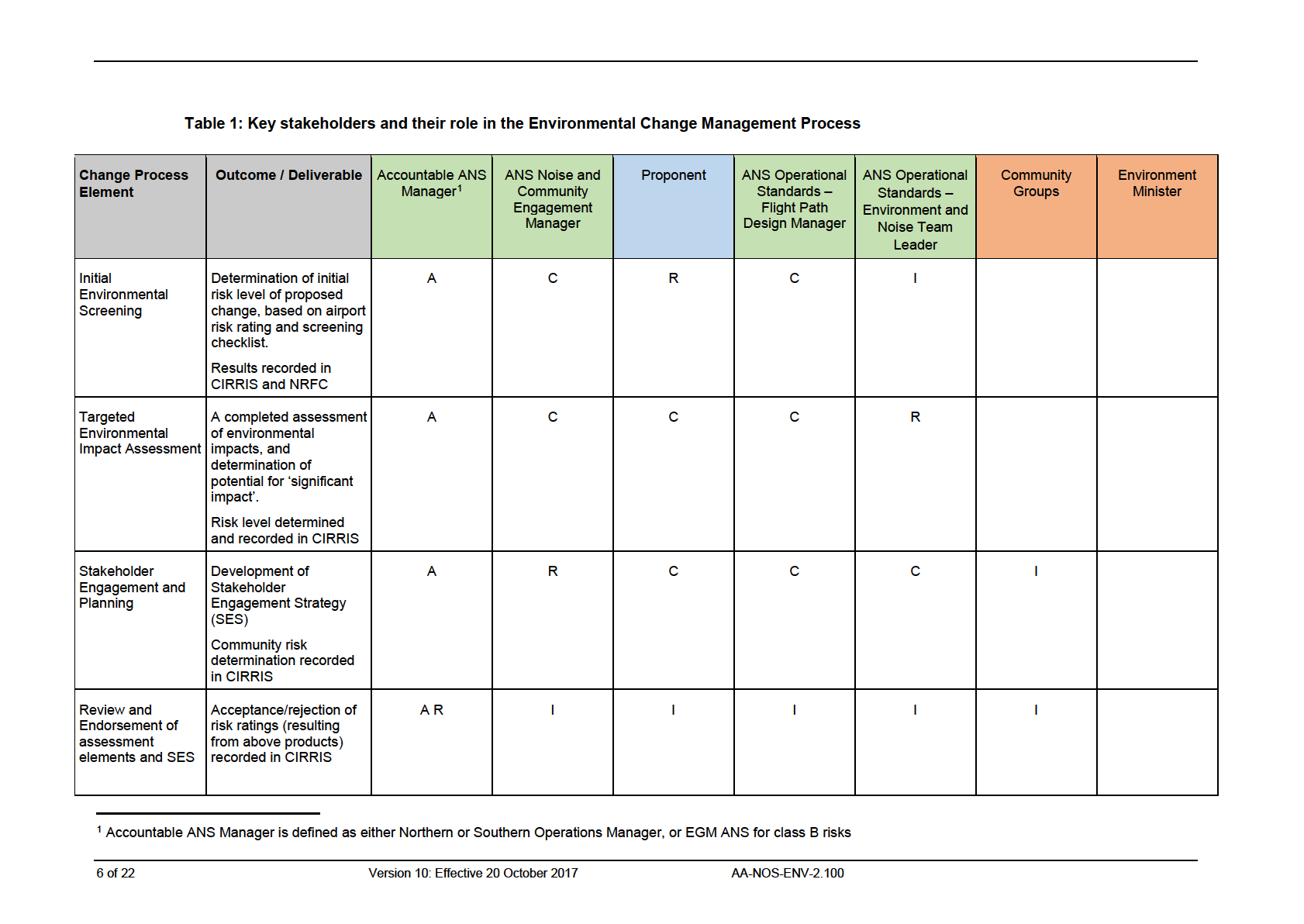
FOI 24-31 - Doc 3
pursuant to the Freedom of Information Act 1982 by Airservices Australia
Released
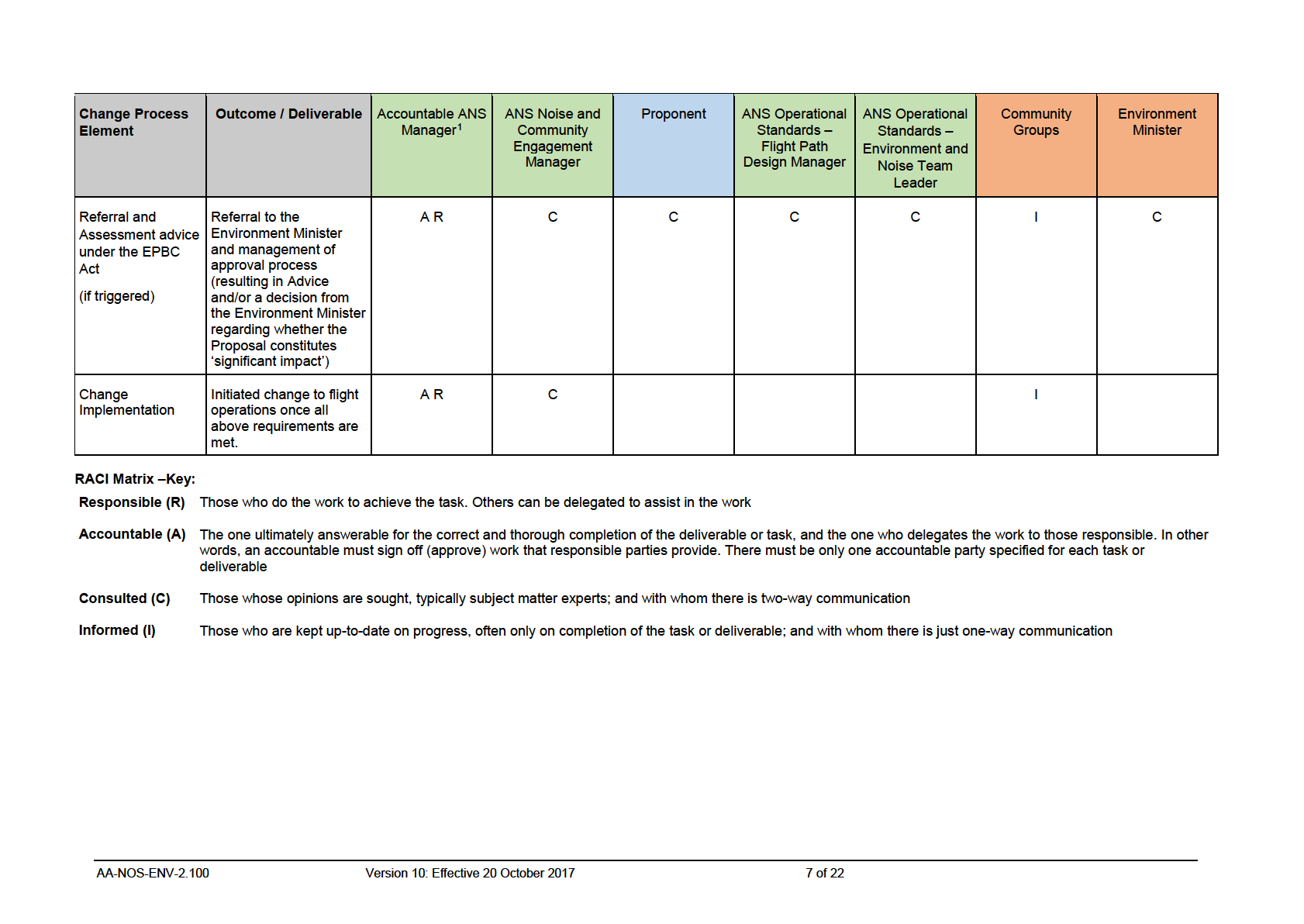
FOI 24-31 - Doc 3
pursuant to the Freedom of Information Act 1982 by Airservices Australia
Released
FOI 24-31 - Doc 3
6
Environment Impact Assessment
Environmental impact assessment (EIA) potentially includes three main stages, as
follows:
1. Initial environmental screening
2. Targeted environmental impact assessment
3. Referral and formal assessment under the EPBC Act
Initial environmental screening (item 1) must be undertaken for all potential changes.
However, the requirements for further environmental assessments (items 2 and 3) will
be dependent on the outcomes of the preceding assessment stage.
The above elements are further explained below. Refer to Figure 1 for a summary of
the environmental change management process.
6.1
Initial Environmental Screening
6.1.1
Purpose
The environmental screening enables the Proponent to self-assess proposals against
potential environmental impacts at a high level using defined criteria (included in
Appendix A). Screening enables change proposals to be expedited by ANS, by
diverting low risk activities away from the requirements of a more detailed
environmental assessment.
6.1.2
Outcomes to be achieved
1. An initial determination of the change risk level, based on the airport
environmental risk rating (refer to Appendix A);
2. Acceptance of the initial risk level for the change in CIRRIS;
3. A determination regarding whether the change can be implemented, or if further
environmental assessment and management is required (according to the
screening criteria methodology, and airport environmental risk rating).
6.1.3
Requirements
1. Environmental screening must be undertaken using the CIRRIS ATC MOC
module, which incorporates the Approved Screening Criteria (included in
Appendix A);
2. Changes can only enter the change assessment process, and undergo formal
screening in CIRRIS, if initiated by the Accountable ANS Manager;
pursuant to the Freedom of Information Act 1982 by Airservices Australia
3. The Screening outcome must be recorded in NRFC.
Released
8 of 22
Version 10: Effective 20 October 2017
AA-NOS-ENV-2.100
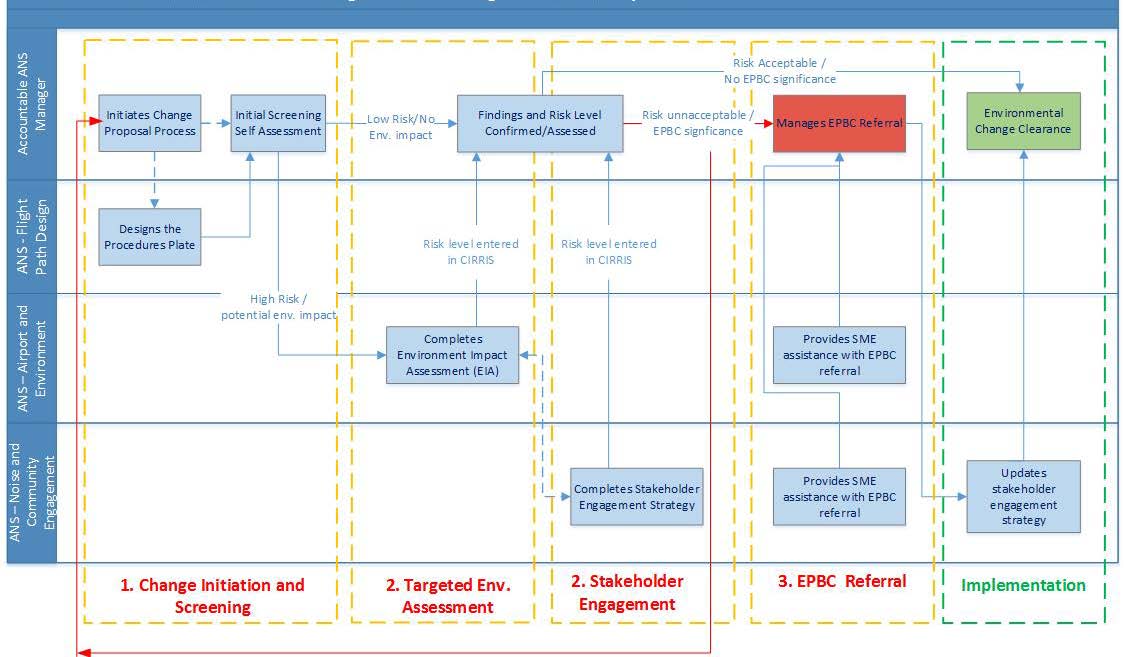
FOI 24-31 - Doc 3
Figure 1– Summarised Environmental Change Management Process
pursuant to the Freedom of Information Act 1982 by Airservices Australia
AA-NOS-ENV-2.100
Version 10: Effective 20 October 2017
9 of 22
Released
FOI 24-31 - Doc 3
6.1.4
Accountabilities
1. The Accountable ANS Manager must ensure that:
a. The requirements and outcomes of the Initial Environmental Screening
are achieved;
b. The risk level is accepted or rejected in CIRRIS;
c. A preliminary options assessment for proposed changes (which
considers environmental cost benefits) is undertaken, prior to detailed
flight path design or environmental assessment.
2. ANS Flight Path Design Manager must ensure that
a. Any proposed changes originating within ANS Flight Path Design unit
are sent to the Accountable ANS Manager for change initiation;
b. Flight paths provided to the Accountable ANS Manager for change
screening, are prepared in the agreed format.
6.2
Targeted Environmental Impact assessment
6.2.1
Purpose
The Targeted Environmental Impact Assessment is required to:
• Conduct further impact assessment, where a requirement has been triggered
through the initial environmental screening;
• Identify and assess potential impacts to the environment (including noise,
emissions, impacts to humans and wildlife, cultural Heritage values);
• Inform the Accountable ANS Manager about levels of environmental risk
associated with proposed flight path changes, as a basis for decision making;
• Meet legal, industry standard, and other impact assessment requirements as
described in:
o Legislation, including the EPBC Act,
Airservices Act 1995, and
associated Ministerial directions;
o Requirements as specified under ISO14001:2015 – Environmental
Management System Requirements.
6.2.2
Outcomes to be achieved
1. A report provided to the Accountable ANS Manager which meets the
requirements of this NOS (including a determination of whether ‘significant
impact’ is triggered under the EPBC Act, and a risk level determination for the
pursuant to the Freedom of Information Act 1982 by Airservices Australia
proposed change);
2. Initiation of an EPBC referral process (if triggered by the assessment);
3. An updated CIRRIS entry for the change, including an environmental risk level;
Released
4. Acceptance or rejection of the risk assessment in CIRRIS.
6.2.3
Requirements
1. The assessment report shall be signed and endorsed by the Environment and
Noise Team Leader;
10 of 22
Version 10: Effective 20 October 2017
AA-NOS-ENV-2.100
FOI 24-31 - Doc 3
2. The Targeted Environmental Impact Assessment shall:
a. Be based on accepted industry practices and environmental
assessment methodologies;
b. Include an assessment of impacts to applicable environment values, as
described under the EPBC Act (including noise, emissions and impacts
to biodiversity values);
c. Include a benefits assessment for the change (including fuel and aircraft
emissions reductions;
d. Have a level of rigor and detail (i.e. ‘short’ or ‘long’ form assessments)
which is informed by:
i. Feedback from the ANS Noise and Community Engagement unit
early in the assessment planning phase, regarding potential risks
and sensitivities that should be considered;
ii. the risk level associated with the change.
e. Include an assessment of ‘significant impact’ as defined under the
EPBC Act;
f. Be quantitative and objective;
g. Be clearly documented in a report and document controlled (using
prescribed templates);
h. Provide an appropriate evidentiary trail for assurance and auditing
purposes;
i. Include a risk assessment and determination of associated
environmental risk level which considers all potential business impacts
(in accordance with Airservices Risk standard AA-NOS-RISK-0001);
j. Include clear conclusions regarding:
i. the potential for environmental impact on key values described
under the EPBC Act. Conclusions shall be supported by cited
literature whether relevant;
ii. whether the change constitutes significant environmental impact
according to the EPBC Act.
k. Include recommendations to address identified significant impacts (i.e.
lodge EPBC Referral or redesign flight path).
3. The assessment outcome shall be updated in CIRRIS;
pursuant to the Freedom of Information Act 1982 by Airservices Australia
4. Assessments shall be subject to a robust critical review process, within ANS
Operational Standards, prior to finalisation;
5. Assessments that are part of an EIS process, shall undergo external peer
review by appropriately qualified experts prior to finalisation;
Released
6.2.4
Accountabilities
1. The Accountable ANS Manager must ensure that:
a. The findings of the Targeted Environmental Impact Assessment report
and risk level are considered in the change assessment planning;
AA-NOS-ENV-2.100
Version 10: Effective 20 October 2017
11 of 22
FOI 24-31 - Doc 3
b. The CIRRIS risk resulting from the environmental assessment is
accepted or rejected in CIRRIS;
c. EPBC referral obligations are met (if triggered), including management
of any subsequent approval processes (refer to section 6.3 for further
details);
d. The results of the environmental assessment are communicated to the
appropriate Management level (if a Class B risk or higher).
2. The ANS Flight Path Design Manager shall ensure that:
a. Accurate information, regarding the proposed flight path, has been
provided to Environment and Noise team in a timely manner, to enable
them to undertake the assessment;
3. The ANS Environment and Noise Team Leader shall ensure that:
a. The Targeted Environmental Impact Assessment report is prepared:
i. in accordance with the requirements of this NOS;
ii. in consultation with ANS – Noise and Community Engagement
Unit;
iii. according to timeframes agreed with the Accountable ANS
Manager.
6.3
EPBC referral and assessment under the EPBC Act
6.3.1
Purpose
The purpose of this stage is to seek advice (through a referral) from the Environment
Minister regarding whether a Proposal constitutes ‘significant impact’ under the EPBC
Act, and if so, to have the Proposal formally assessed.
This is required for all Proposals which have met the criteria for ‘potential significant
impact’ under the Targeted Environmental Impact Assessment (described in Section
6.2, above), and where the Proponent has decided to proceed with the Proposal as
planned.
6.3.2
Outcomes to be achieved
1. A request for advice (i.e. an EPBC Referral) sent to the Minister by the
Accountable ANS Manager, regarding whether or not the Proposal is likely to
result in 'significant impact'.
2. Advice and/or a decision from the Environment Minister regarding whether the
pursuant to the Freedom of Information Act 1982 by Airservices Australia
Proposal constitutes 'significant impact' and any further assessments or actions
required under the EPBC Act (following referral of any Proposal to the Minister
for assessment).
3. If the Proposal is deemed by the Environment Minister (following referral) as
likely to have a 'significant impact' (i.e. constitutes a 'controlled action'):
Released
a. An environmental assessment report (in whichever form specified) sent
to the Environment Minister, for formal assessment under the EPBC Act;
12 of 22
Version 10: Effective 20 October 2017
AA-NOS-ENV-2.100
FOI 24-31 - Doc 3
b. A decision from the Minister, following review of the environmental
assessment report, regarding whether to approve the action, and what
conditions (if any) to impose.
4. The assessment outcome shall be updated in CIRRIS.
5. Approval commitments (as described in the referral) or conditions set by the
Minister, are captured, tracked and enacted.
6.3.3
Requirements
1. EPBC referrals shall be prepared and managed in accordance with legislated
mechanisms and timeframes, as described in the EPBC Act2;
2. EPBC assessment outcomes shall be recorded in CIRRIS, including updated
risk ratings associated with the change.
6.3.4
Accountabilities
1. The Accountable ANS Manager shall:
a. Manage the EPBC referral and assessment processes (including
document preparation, endorsement and provision to the Environment
Minister for assessment);
b. Manage any liaison, actions required, or further approval processes
resulting from Ministerial advice;
c. Record the outcomes of the assessment in CIRRIS and update, and or
accept, the associated risk.
2. The Environment and Noise Team Leader shall:
a. Provide environmental SME advice and assistance regarding the EPBC
approval process, as agreed with the Accountable ANS Manager.
3. The ANS Noise and Community Engagement Manager shall:
a. Provide SME advice and assistance regarding community consultation
matters, as agreed with the Accountable ANS Manager;
b. Update the Stakeholder Engagement Strategy as required, to reflect the
outcomes of the EPBC Assessment process.
7
Stakeholder engagement
7.1
Purpose
The purpose of stakeholder engagement is to identify, manage and mitigate potential
pursuant to the Freedom of Information Act 1982 by Airservices Australia
environmental impacts on the community resulting from aircraft changes, particularly
with respect to noise.
This is predominantly achieved through the development and implementation of a
Stakeholder Engagement Strategy (SES), which sets the requirements for
Released
communicating Airservices’ management of flight path changes.
2 For further information refer to the Federal Government Guideline ‘Actions on, or impacting upon, Commonwealth land,
and actions by Commonwealth agencies’.
AA-NOS-ENV-2.100
Version 10: Effective 20 October 2017
13 of 22
FOI 24-31 - Doc 3
7.2
Outcomes to be achieved
SES development
1. Development of a SES, which reflects the findings of the environmental impact
assessment and other considerations relating to impacts to the community;
2. Guidance provided to ANS Environment and Noise unit regarding the required
level of environmental impact analysis (based on any heightened community
risks);
3. A community impact risk assessment which is recorded in CIRRIS and
accepted or rejected by the Accountable ANS Manager;
4. Ultimately a decision by the Accountable ANS Manager regarding whether or
not to proceed with implementing the Proposal or whether redesign is
necessary.
SES Implementation
5. Implementation of the SES to relevant stakeholders (including relevant CACGs,
other Community groups as required);
6. A revised risk assessment and agreed level of overall Proposal risk (either
Class A, B, C, or D) post implementation of the SES.
7.3
Requirements
SES Development
1. Development of the SES shall be iterative, commencing in conjunction with the
Targeted Environmental Impact Assessment described in Section 6.2.
SES Implementation
2. SES implementation methodology will vary in each case (targeted to the
particular Proposal) but, as a minimum shall include:
a. Information provided and/or a presentation to relevant community
groups and bodies (e.g. Airport Community Aviation Consultation
Groups – CACGs) where the proposed change is communicated (see
specific requirements in 2 below);
b. Publication on the Airservices website;
c. Participation in other activities required by other stakeholder
engagement plans (e.g. Communication to politicians) where necessary;
d. A request for comments on the intended Proposal to be provided by a
specified date (where community feedback is sought).
pursuant to the Freedom of Information Act 1982 by Airservices Australia
3. Community consultation under the SES shall:
e. Be targeted to all areas potentially affected by the change;
f. Provide justification for the change, explicitly describing how any
negatives are balanced by benefits, and on what basis the chosen
approach is optimal compared to viable alternatives;
Released
g. Describe timeframes for implementation, specific proposed flight paths,
and likely noise levels and associated impacts;
14 of 22
Version 10: Effective 20 October 2017
AA-NOS-ENV-2.100
FOI 24-31 - Doc 3
h. Consider the social, economic and cultural context of the communities
being consulted to ensure genuine engagement and accessibility of
information.
4. The community shall receive all relevant information relating to a change
proposal within a reasonable timeframe, to provide them with the opportunity to
effectively give feedback prior to implementation.
7.4
Accountabilities
1. ANS Noise and Community Engagement Manager shall:
a. Lead and manage development, implementation and delivery of the
SES (including all consultation and delivery at relevant forums -
including CACGs and Community groups);
b. Lead the environmental risk review and update (pre and post SES
implementation), in collaboration with ANS Environment and Noise
team;
c. Compile all feedback and consultation records and communicate the
findings to the Accountable ANS Manager.
2. The Accountable ANS Manager shall:
a. Review (i.e. accept or reject) and provide comment on the risk
assessment findings.
3. The ANS Environment and Noise Team Leader shall:
a. Participate in implementation of the SES (as Subject Matters Experts)
as required and as agreed with the Accountable ANS Manager.
8
Assurance assessments
Business groups with accountabilities described in this NOS shall conduct periodic
assurance assessments to confirm that associated requirements and obligations are
being met.
Additionally, Safety and Assurance Group shall conduct targeted assurance
assessments of key elements of the environmental change management process on a
periodic basis.
9
Post implementation reviews
Accountable ANS Managers shall conduct periodic post implementation reviews (PIRS)
of implemented flight path changes, to verify conclusions made regarding potential
pursuant to the Freedom of Information Act 1982 by Airservices Australia
environmental impacts and risk levels, as well as the overall effectiveness of the
change management process.
As a minimum, post implementation reviews shall:
1. Draw conclusions regarding whether or not the change outcomes met
Released
predictions made in the Environmental Impact Assessment and SES;
2. Highlight any ongoing actions required;
3. Identify any required improvements to associated environmental management
processes and documentation.
AA-NOS-ENV-2.100
Version 10: Effective 20 October 2017
15 of 22
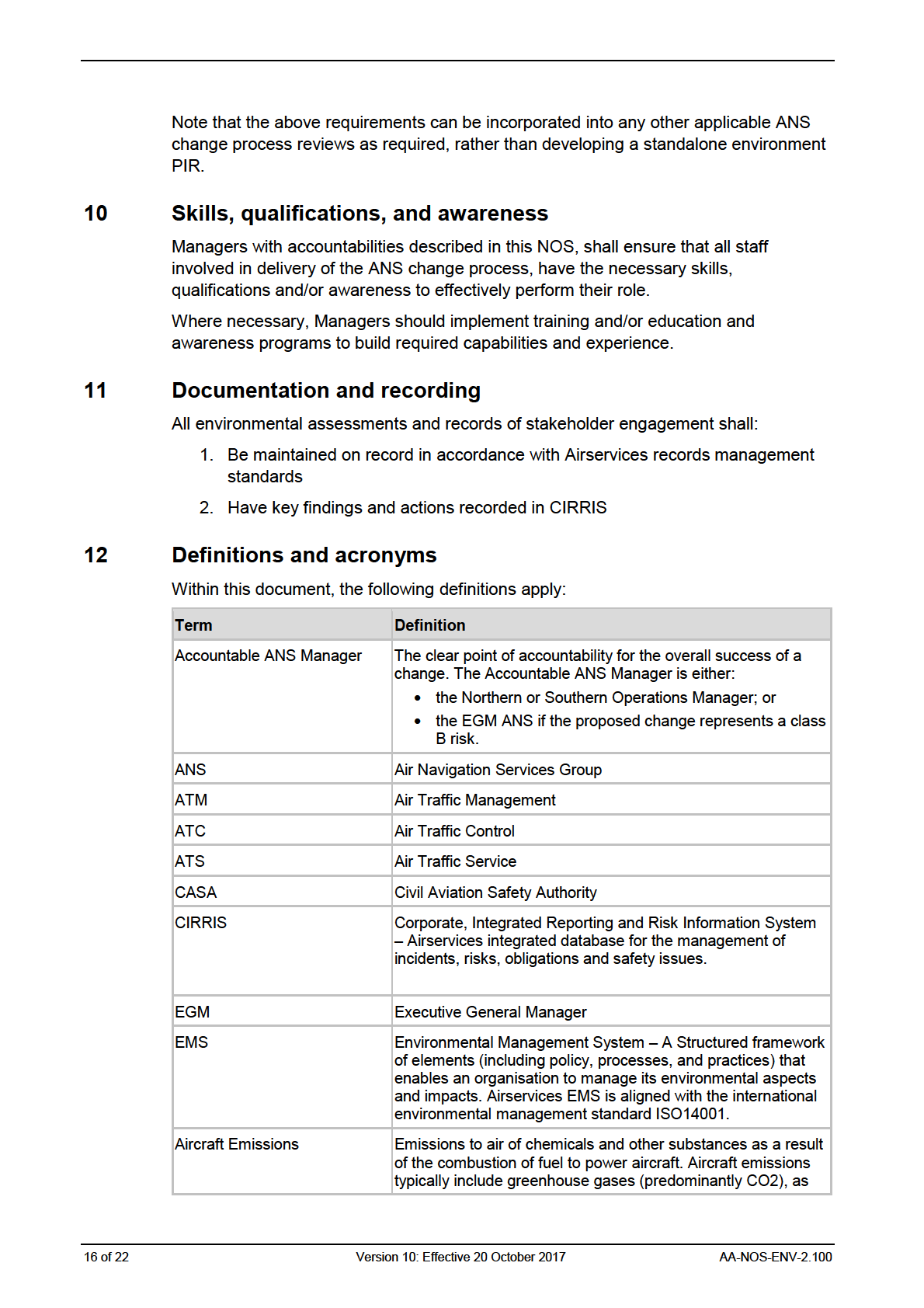
FOI 24-31 - Doc 3
pursuant to the Freedom of Information Act 1982 by Airservices Australia
Released
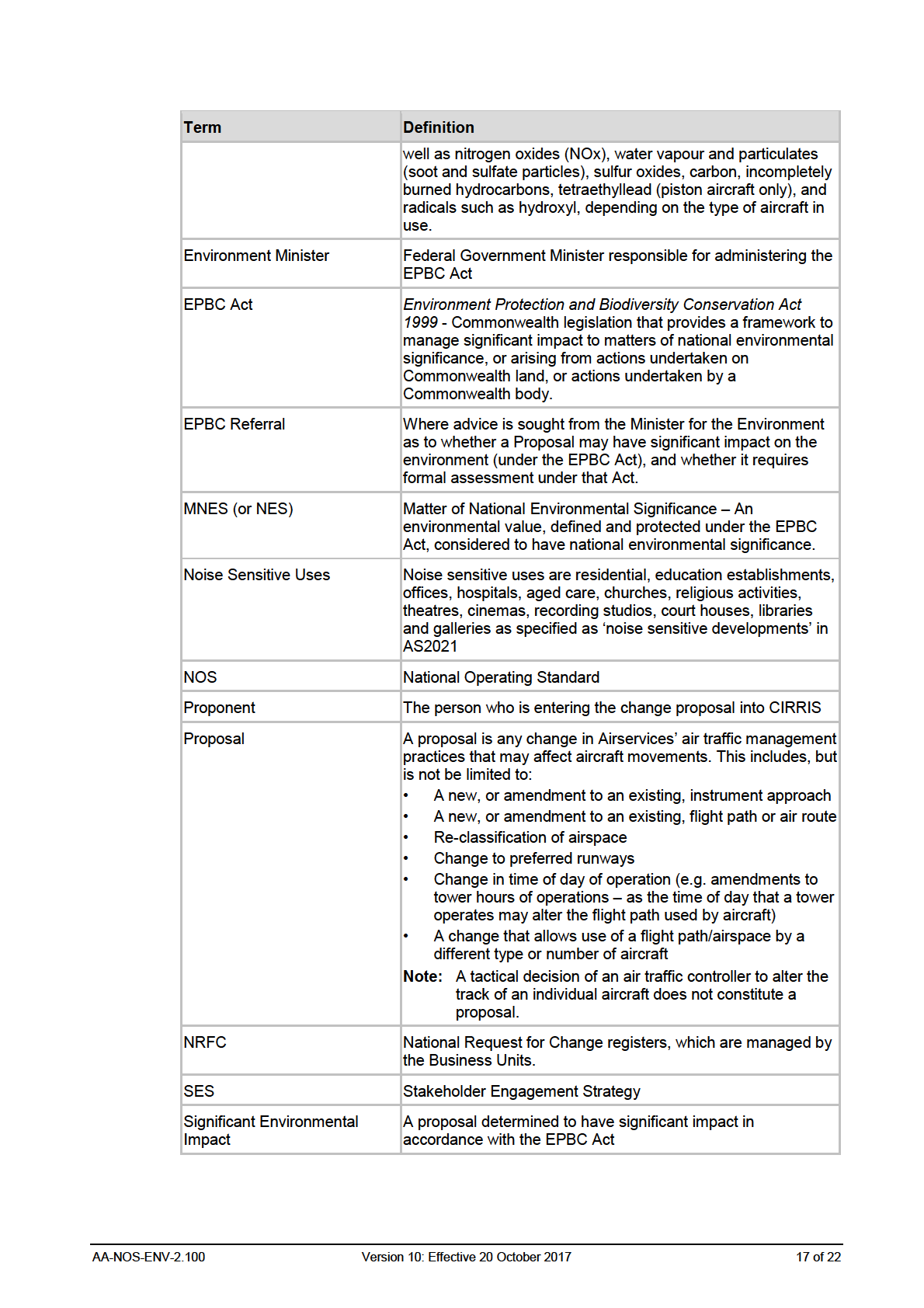
FOI 24-31 - Doc 3
pursuant to the Freedom of Information Act 1982 by Airservices Australia
Released
FOI 24-31 - Doc 3
13
References/related documents
13.1
Internal documentation
•
Environment Policy - C-POL0030
•
Environmental Risk Management Procedure – ENV-PROC-0004
•
Environmental Management System Objectives and Requirements – AA-NOS-
ENV-0001
•
Airservices Communication and Consultation Protocol -
http://www.airservicesaustralia.com/wp-content/uploads/Communication-and-
Consultation-Protocol WEB.pdf
13.2
External documentation
•
SEWPaC 2010, ‘Actions on, or impacting upon, Commonwealth land, and actions
by Commonwealth agencies’ Significant impact guideline 1.2, Environment
Protection and Biodiversity Conservation Act 1999.
•
AS2021-2000: Acoustics-Aircraft noise intrusion-Building siting and Construction,
Standards Australia International Ltd, Sydney, NSW 200
pursuant to the Freedom of Information Act 1982 by Airservices Australia
Released
18 of 22
Version 10: Effective 20 October 2017
AA-NOS-ENV-2.100
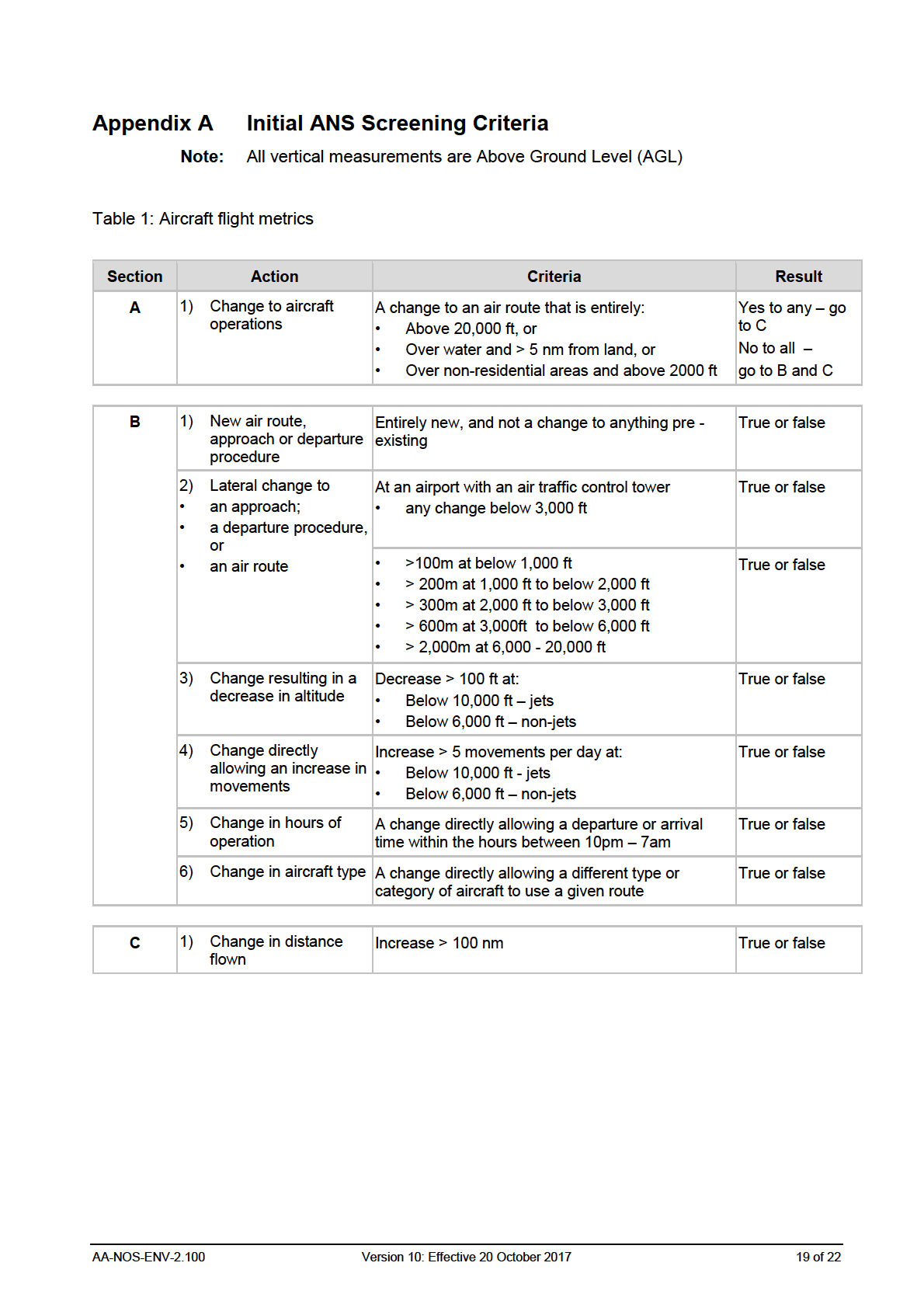
FOI 24-31 - Doc 3
pursuant to the Freedom of Information Act 1982 by Airservices Australia
Released
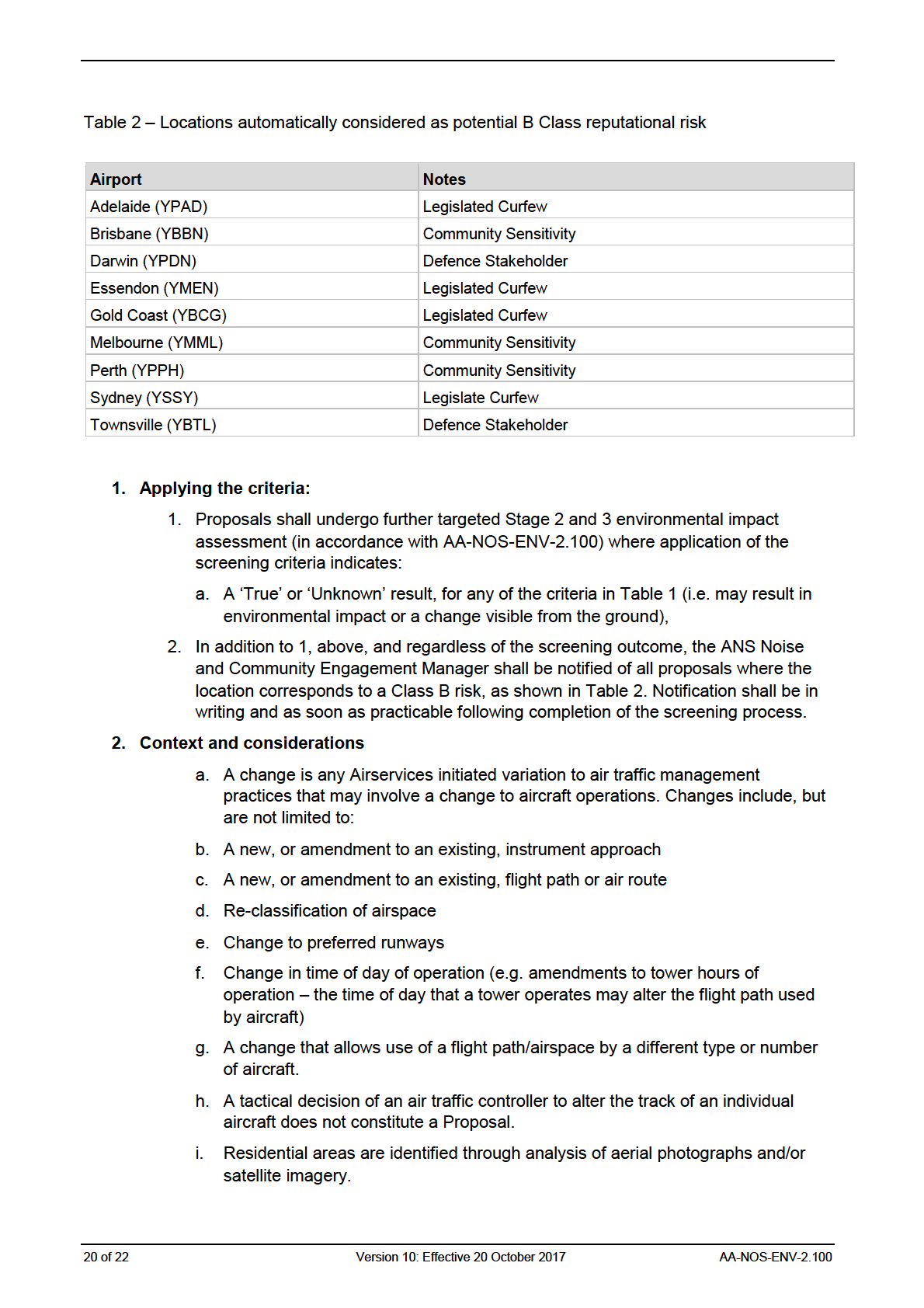
FOI 24-31 - Doc 3
pursuant to the Freedom of Information Act 1982 by Airservices Australia
Released
FOI 24-31 - Doc 3
j. Screening criteria are designed to fast-track proposals with impacts far below
the thresholds for significance applied to full assessments.
k. Screening criteria may only be applied by proponents who have undergone
appropriate training in the use of, and basis for, the criteria.
l. Average traffic levels may be applicable at locations where there is little
variation in movements throughout the year unless specifically excluded in the
table above. Also specifically excluded are those locations that host special
events attracting additional movements such as air shows.
pursuant to the Freedom of Information Act 1982 by Airservices Australia
Released
AA-NOS-ENV-2.100
Version 10: Effective 20 October 2017
21 of 22
FOI 24-31 - Doc 3
Appendix B
Other Business Revenue – explanatory notes
Other Business Revenue (OBR), otherwise referred to as ‘Unregulated Revenue’ or
Non-Airways Revenue, relates to the provision of goods or services other than those
which are provided as part of the regulated service that is subject to the Long Term
Pricing Agreement (LTPA) with customers. For the avoidance of any doubt, OBR is a
term applied to account for those activities not funded through airways revenue.
Airservices OBR includes (but is not limited to):
• provision of charting services and other publications
• maintenance or provision of navaids under contract
• provision of air traffic services under contract (e.g. for Solomon
Islands and Nauru)
• delivery of training and
• funds we receive for official development assistance (aid) activities.
For further information on OBR, refer to the following documents:
• C-PROC0194
• MI-0205
pursuant to the Freedom of Information Act 1982 by Airservices Australia
Released
22 of 22
Version 10: Effective 20 October 2017
AA-NOS-ENV-2.100









